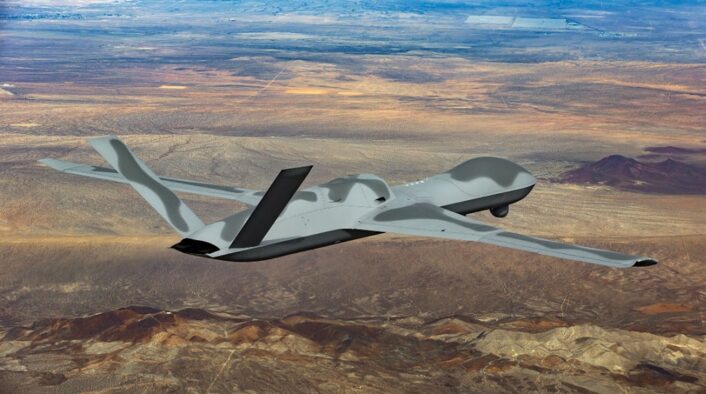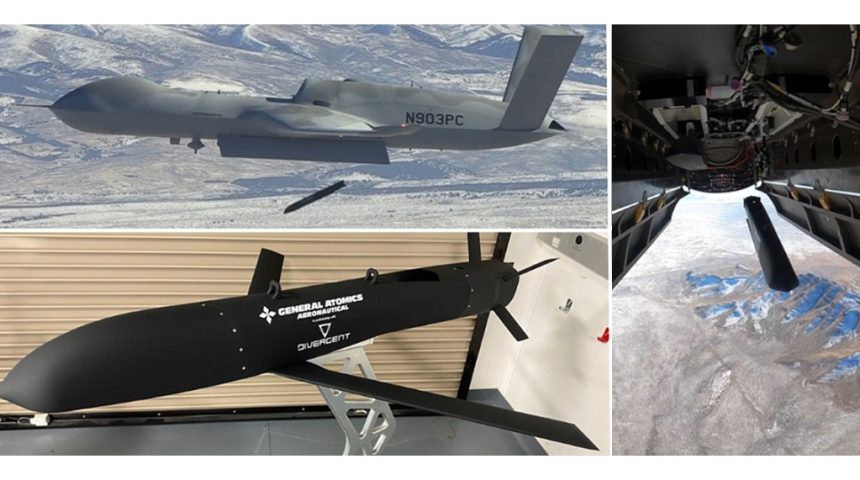The new A2LE was developed in partnership with Divergent Technologies in a controlled, low-risk approach.
General Atomics announced the successful inflight release of its new Advanced Air-Launched Effects (A2LE) platform from the internal weapons bay of a MQ-20 Avenger Unmanned Aircraft System. Although this was only disclosed last week, the demonstration took place on Nov. 28, 2023, over Dugway Proving Ground, Utah, capping a manufacturing, structural test, and flight demonstration campaign.
General Atomics’ design and engineering team partnered with Divergent Technologies for a rapid, low-cost design and manufacturing of the A2LE demonstration vehicle. The company said the airframe was entirely built with additive manufacturing (commonly known as 3D printing) and designed to meet the captive carriage and ejection loads of the MQ-20. The partnership, in fact, allowed to exploit the benefits of the Divergent Adaptive Production System, which was created to design, additively manufacture, and automatically assemble complex structures for automotive, aerospace, and defense applications.
“This demonstration was a crucial first step in demonstrating GA-ASI’s ability to rapidly develop, manufacture, and test a Small Unmanned Aircraft System (SUAS) in a controlled, low-risk approach,” said Mike Atwood, vice president of Advanced Programs at GA-ASI. “A2LE demonstrates the coupling of GA-ASI’s pedigreed aircraft design capabilities with Divergent’s DAPS, paving the way for continued maturation of affordable, modular SUAS platforms that can be tailored to meet warfighter needs at a fraction of the cost and lead time of currently fielded systems.”
General Atomics further detailed that the topology-optimized additive manufactured structure was validated via proof and pit ejection testing prior to the flight demonstration. The demonstration highlighted the design efficiencies that can be realized when AM is incorporated early in the design process and throughout the vehicle. It was also a key step in validating the AM process and material properties for incorporation in future systems to be employed by both manned and unmanned platforms.

The company says that the A2LE platform provides a low-risk, low-cost, tailorable solution that bring affordable mass to the warfighter, with modular payload provisions to meet the requirements of current and future mission objectives. This further confirms the current trend in the UAS sector, as more and more low-cost, often expendable, modular UAS systems are being envisioned for the future Multi-Domain and Joint All-Domain Command and Control-enabled scenarios.
For an instance, General Atomics says a network of A2LEs could create a persistent, expansive grid for surveillance, attack, enemy air defense suppression, or communication pathways, supporting and elevating capabilities of current and future manned or unmanned platforms. Similar employment methods are being also envisioned by the U.S. Army, which is actively working to integrate Air Launched Effects in its operations, with the MQ-1C Gray Eagle and the Future Vertical Lift aircraft as the main launching platforms.
Future employment methods would see unmanned assets able to autonomously employ ALEs to achieve the objectives. Advancements in this area saw General Atomics demonstrating its hardware-agnostic, open standards-based autonomy ecosystem for Unmanned Combat Air Vehicles on the MQ-20 in November. Autonomy skills were used to meet multiple objectives for collaborative combat missions and close the Find, Fix, Track, Target, Engage, and Assess (F2T2EA) engagement chain using a mix of Live, Virtual, and Constructive (LVC) entities.
The test flight also demonstrated the ability to rapidly plug and play both U.S. Navy and U.S. Air Force autonomous unmanned technologies together. It further leveraged autonomy from three separate sources: government-provided human-machine interface (HMI) hardware, GA-ASI’s autonomy core, and orchestration of these components using Waveform X, a non-proprietary U.S. government-owned communications capability.









